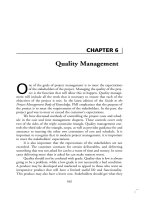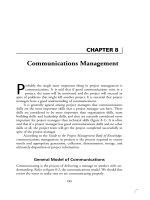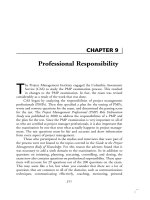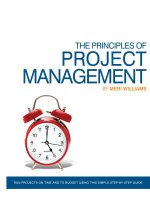The balancing act – Project Management’s Triple Constraint ppt
Bạn đang xem bản rút gọn của tài liệu. Xem và tải ngay bản đầy đủ của tài liệu tại đây (178.87 KB, 16 trang )
The balancing act – Project Management’s
Triple Constraint
“You might say every one of us is a fiddler on the roof - trying to scratch
out a pleasant, simple tune without breaking his neck”
“It isn’t easy”, says Tevye in the opening dialogue of
“Prologue/Tradition” (the first song of the musical). You
know what? He’s right. Listen carefully to the opening of
the music to this song. You’ll hear a single violin assert and
then repeat the Fiddler theme followed by other strains of the
theme in rondo form. Think of this lone introductory violin
as the project’s statement of work, and the voices of the other
violins coming in as attempting to tweak the statement of
work – that is, applying new constraints or making new
requests. Some of these “new voices” will be in concert with
the project’s objectives, and some will be in counterpoint,
leading to music which is interspersed with emotion,
conflict, and harmony. In a musical score, this is by design.
In this particular piece from The Fiddler, the dialogue goes on
to be a mix of cacophonous debate and a celebration of
human accomplishment, capability, and joy. Such is a
project, except that these voices are added not by design, but
somewhat at random.
As a project manager you are already in a precarious
situation – on the peak of a roof, you might imagine. Why?
Projects by definition are new territory. After all, in a
project, we are not processing a tax return; we are
Comment [ALG1]: Terms to have
defined before this chapter:
Risk
Stakeholders
Product of the project
PMBOK Guide
Comment
[
ALG
2
]:
Note to Rich and
Ranjit – be sure to refer back to this and
to discuss that we DO INDEED have
some control over these voices, if we
have put together a communications
management plan.
introducing new tax software. We are not changing or even
manufacturing a light bulb; we are introducing a new line of
bulbs or opening a new bulb factory.
Now take that precarious situation and add to it the effects
of two of the most critical concepts in project management –
stakeholders and risks. As you work – up there on the roof
– stakeholders are pushing on you. Left, right, forward
back. Some may be tugging and pulling on your feet and
jeopardizing your very foothold.
What do these stakeholders want from you?
Some want the project to be finished sooner. Some want the
project to cost much less. Some will want your project’s
product to include much more – or to be very different -
than originally asked for and agreed to. Some will want
combinations of these modifications. Some, usually your top
executives, or most demanding customers, will want all of
these. Even worse, they will want it without losing anything
originally agreed to in the project’s statement of work. As
you’re trying to fiddle, they’re tugging at your legs, pulling
and pushing you in multiple directions, some with the intent
to knock you down, most with the best of intent but with the
same possible outcome.
In addition to these immediate and local human forces, there
are also the effects of good and bad fortune on a broader
scale. The weather, the government, the stock market, the
price of fleece in Nice – all of these could provide your
Comment [REM3]: Reference to
Cape Wind project and the SOS group.
Yes, SOS is a stakeholder in Cape Wind.
project with opportunity or threats. In project management
parlance, this is Risk (see chapter ___). In our fiddler’s
analogy, you can think of Risk as the very roof itself shaking,
shifting, tilting, sagging, rising… sometimes to the fiddler’s
advantage, and sometimes to his peril. Either way, the
fiddler needs to make adjustments or face a painful fall
(well, maybe the fall won’t be painful, but the impact with
the Earth surely will be).
Can we begin to see why Tevye says, “It isn’t easy”? And, as
Al Pacino, playing the fiery ex-Lieutenant Colonel Frank
Slade said in “Scent of a Woman”, in that famous scene
where he is testifying on behalf of his young friend
Charlie…we’re “just getting warmed up”.
PM’s Triple Constraint
Let’s look in some detail at the fundamentals of the triple
constraint. Before we do, let’s bring in a definition of a
project from the IPMA which will become an important
backdrop for the triple constraint:
A time and cost restrained operation to realize a set of defined
deliverables (the scope to fulfill the project’s objectives) up to
quality standards and requirements.
1
1
International Project Management Association
Looks like time, cost, scope, and quality are the key words,
doesn’t it?
We’ll review those below, and later, each will be treated
more thoroughly in their own chapters.
Cost:
Unless you are fortunate enough to be working on a project
funded by an infinitely wealthy sponsor, you can
instinctively understand the cost/resource constraint. Funds
are limited. You cannot put an unlimited number of staff
members on the project. “Money is no object” only means
that the cost constraint may be the most flexible, not that there
are infinite Dollars or Euros to spend. Here are some
elements of cost constraints
2
along with examples:
Budgeted expenditures: Spending in June is limited to $110,000
Personnel limits: 3 Scientists and 1 Technician, 14 staff-years of effort
Equipment: 12 Spectrometers, 5 forklift trucks
Consumables: 3,000 drums of paint, 160 tons of concrete mix, 500GB of
storage space
Overhead/Administration: Project Management software must be Brand
X, version Y
Intangibles: Use of political power, favors, negotiation, concessions
Time:
Even if a “wonder of wonder, miracle of miracles” takes
place and you suddenly receive an infinite amount of
2
Dobson
resources for your project, the very definition of a project
prevents you from having an infinite amount of time. A
project, you’ll recall, is defined by the PMBOK Guide as
having a definite beginning and end. So, your project will
have a date by which it simply must be completed. And
while that date is fixed, variations in the timing and duration
of contributing tasks and subtasks will inevitably put
pressure on that end date. Scheduling and sequencing
techniques such as CPM and network diagrams (see section
___) , and sometimes the simple disciplined use of a shared
project calendar, help project managers deal with the time
constraint.
Here are some elements of time constraints:
Calendar Deadline: Completed by June 24, 2010
Event-related: Before concrete sets, by 2Q state tax filing deadline,
immediately after release 1.5.1 passes QA Testing
ASAP: Top management deems this activity hot, get it done right away
Scope:
Unlike the constraints set on a project by time and resources,
which are “used up” by the project as you (hopefully) make
progress towards the project’s product, scope is a constraint
which is set and limited by the vendor/supplier/seller in
agreement with the customer/client/buyer in the form of a
contract (see section ____).
Scope Creep
Violation of this constraint must be carefully watched, even
when (maybe especially when) changes are being made in
deceivingly small increments. These small, seemingly
innocuous changes to the project – or the product of the
project – are collectively called scope creep. We cannot stress
enough how important it is to fully understand the project’s
scope up front and in crystal-clear, commonly-understood
terms between all stakeholders. The authors’ experience
shows that if scope is given only lip-service, it will become
an insidious issue that really won’t rear its ugly head until
near the end of the project, when a “misunderstanding”
between parties over requirements or scope is absolutely
devastating. One of the most dreaded phrases you will
ever hear as a PM is, “I thought they meant …”, especially
when that is uttered late in the project. Spend extra time –
even to the point of obsession – defining scope at the
beginning of the project and keep your project energy
focused on defining, communicating, defending and
managing scope throughout the project. It will make a
tremendous difference in your chance for a successful – and
less stressful – project completion. The other phrase that
should send shivers down your spine is this one: “it’s just a
little change…”. This reference to an incremental change –
for those of us in the engineering fields, just one little epsilon
– is the way that scope creep got its name. It may only be
incremental but it must be controlled or it will kill your
project.
Here are some elements of scope constraints:
Performance Criteria:
• 600 GB of storage
• vehicle must have 25-person capacity
• < 10
-9
errors per second
• needs to be understood by people with 6
th
grade English language
skills
Result-oriented objectives:
• Enable division to reach $1B sales per year with 35% margin by EOY
2009
• Product certified by International Certification Agency
Now, if one of your stakeholders asks you to increase
storage to 610 GB, a vehicle that has a 26-person capacity,
consider this scope creep. Even these “tiny” changes must
be approved by a project authority, usually a Change
Control Board.
Quality:
Here is the current American Society for Quality (ASQ)
definition of quality:
Quality: A subjective term for which each person has his or her own
definition. In technical usage, quality can have two meanings: 1. the
characteristics of a product or service that bear on its ability to satisfy stated
or implied needs. 2. a product or service free of deficiencies.
3
This means that even between the two authors of this book,
there is a potentially different definition of this basic term.
3
ASQ Web page www.asq.org
We’ll agree to define project Quality (for now) as a
producing a result for the customer of the project which
best balances the use of resources and time and meeting all
of the requirements of the scope. Quality has been defined
by some
[footnote]
as “what the customer wants”. Some
experts
[footnote]
believe that the “triple constraint” should be a
“quadruple constraint”, with “client acceptance” or quality
as the fourth constraint. Some have said that there are five
constraints – with Risk being the fifth. So, there is conflict in
the world of constraints, yet there seem to be no constraints
in the world of conflict when it comes to deciding on
constraints in project management!
The Constramid®
At this point we would like to introduce you to the
Constramid. See Figure ___. If you want to build one, see
the pull-out card in Appendix ___. The Constramid is a
conceptual device you can use to help you understand how
these constraints affect you as the Fiddler on your project.
The Constramid is a simple 3D pyramid, with three
triangular facets named simply Time, Cost, and Scope, and a
triangular floor named Risk/Uncertainty. To make this very
personal, imagine that you’re standing- just as Tevye’s
fiddler – on the peak of this structure.
Why is Risk and Uncertainty considered the Constramid’s
floor? We assert that the main work of project managers in
the real world is managing uncertainty and risk. Managing
of schedules and timelines in the face of 100% certainty does
not require a professional project manager’s touch. It is
precisely the effects of uncertainty and risk that make the job
of project management challenging, interesting, and even
fun. No guts, no glory. You should picture the floor as being
“in motion”. Risks and uncertainties – such as a fire in your
development lab, a new competitor arriving on (or leaving)
the scene, a change in government regulations – imply
movement. This is where our structure becomes interesting
because in addition to being promoted from two dimensions
to three (from a triangle to a pyramid), it is not limited to
being a static form. Indeed, it is extremely dynamic. Risks
and uncertainty exert force on the facets of your project’s
schedule, budget, and requirements – the now familiar facets
of Time, Cost, and Scope. You can imagine that if the base is
changing shape, the facets of the Constramid are being
forced to change also.
So where’s Quality? We further assert that quality must be
inherent in each of the facets of the Constramid. Each facet
should be imagined as having “What The Customer Wants”
woven into its very fabric. To quote the PMBOK® Guide,
“High quality projects deliver the required product, service
or result within scope, on time, and within budget”.
The Constramid: a closer look
Let’s look at the Constramid in more detail. Figure 1 is a
flattened Constramid, unfolded from 3 dimensions to 2 so
that (1) we could print it on a two-dimensional page, and (2)
so that you can more clearly see the boundaries and
intersections.
Figure 1-1 shows the boundaries – the lines formed at the
intersection of the triangles – Risk/Uncertainty with Cost,
Scope, and Time respectively. Note that the core of this
discussion is one of Risk Identification, which we cover on
its own in section ________. But for now, back to the facets
of the Constramid - let’s examine them one at a time.
Boundary A: Cost/Risk
At this boundary we deal with uncertainties related to our
project’s costs and resources. If we don’t know or don’t care
enough about this boundary, variations in costs will control
the project rather than the other way around. One of the
authors was involved in a venture to import candies from
The Netherlands. The group (optimistically) ignored the
exchange rate between the US Dollar and the Euro, which at
the time favored the Dollar at about a 0.85 Euros to the
Dollar ratio. What we were implicitly doing, of course, was
making an assumption that the exchange rate would be
stable. Unfortunately for the venture, this flipped around so
that the US Dollar was worth only 0.85 Euro, and the
business case fundamentals fell apart. Note that if the
exchange rate had gone the other way – so that the Dollar
was even more strikingly in a favorable position, this still
represents movement of Boundary A, however this would
have been an “Opportunity” instead of a “Threat”. Either
way, we need to have taken this into account consciously
and to have been aware that there was a Cost/Risk boundary
here and we needed to understand the dynamics of that
boundary with respect to our project.
Boundary B: Time/Risk
At this boundary we face variability in schedules, durations,
milestones, and deadlines. Note that from the author’s
experiences, deadlines tend to be stubbornly fixed or
accelerated inwards, never pushed out!
To get a better grip on the Time/Risk boundary, PMs should
use industry standard data, prior experience, expert
judgment, and other schedule management techniques (see
section ___) to verify norms and truly understand the overall
project impact of these variations.
Boundary C –Scope/Risk
As previously mentioned, this can take on the form of scope
creep, in which the boundary moves imperceptibly slowly
but before you know it, the project is almost unrecognizable.
Take the 2008 Beijing Olympics as an example.
BEIJING May 8, 2006 (AP)— Work on a shooting range for the 2008
Beijing Olympics has been suspended after the discovery of imperial-
era tombs on the site, newspapers and an antiquities official said
Monday.
The tombs, found in mid-April, are believed to date back five to six
centuries to the Ming dynasty, and may be those of eunuchs serving at
the imperial court, the Beijing Morning Post said.
Beijing has been the site of imperial and other capitals for more than
1,000 years, and many major building projects unearth gravesites or
relics. Most are removed or destroyed before experts can examine
them.
A spokeswoman for the Beijing Olympic organizers, Zhu Jing, said the
find accounted for only a small part of the construction site and
"shouldn't affect the work too seriously."
"We'll let everyone know if there is a major discovery," Zhu said.
An official of the Beijing Cultural Relics Department, Liu Baoshan,
declined to give an age for the tombs and said no details would be
released until a final report is drawn up.
Archaeologists have found coins, ceramics and jade in the tombs at
the shooting range on the Chinese capital's western outskirts, the Post
and other papers said.
An Associated Press photographer who visited the site Monday saw
antiquities officials at work on several pits dug into an area on the
edge of the construction site, where work otherwise appeared to have
halted. Workers refused to answer questions and demanded the
photographer leave the area.
Olympics organizers broke ground in July 2004 for the shooting range.
The main Olympic facilities are on Beijing's north side, while other
facilities are scattered around the city.
Beijing has been racing ahead with construction of venues for the
games. Most have proceeded smoothly, although there have been
some protests by people whose homes have been destroyed to make
way for new stadiums and gymnasiums.
When the project managers for the Olympics began their
work, they were not intending to get involved with
archaeologists and tombs. But risk has a strange way of
changing the whole focus of your project in unpredictable
ways.
OK, so you can hopefully picture our Fiddler atop the
Constramid, faced with keeping his balance while the facets
of the structure are tilting and moving and perhaps the
whole structure itself is being raised and lowered. What
other things affect his balance?
We can think of the project’s complexity in terms of the
slipperiness of the roof. A complicated project will make for a
slippery roof – making it that much harder to gain a
foothold.
What measurements of project complexity exist? One we
prefer to use is CIFTER
4
, which defines seven complexity
factors:
• Stability of the overall project context
• Number of distinct disciplines, methods, or approaches
involved
• Magnitude of legal, social, or environmental implications from
performing the project
• Overall expected financial impact (positive or negative) on the
project’s stakeholders
• Strategic importance of the project to the organization or
organizations involved
• Stakeholder cohesion regarding the characteristics of the
product of the project
4
Crawford-Ishikura Factor Table for Evaluating Roles, from GAPPS framework
• Number and variety of interfaces between project and other
organizational entities
If each of the above factors are at the high end of the
spectrum, you can imagine how much more complex the
project would be and in turn the additional ‘difficulty factor’
for our Fiddler.
Thinking with distributions in mind
Another important principle for PMs to follow is this:
although project stakeholders (team members, functional
managers, customers, and especially contributors) will tend
to speak project cost, scope and time numbers in terms of
specific fixed numbers or dates, you need to hear those
numbers in terms of a distribution (see figure ___). Visualize
a distribution and push back on the information. Ask the
contributor for their confidence level in the estimate and
how much “plus/minus” variance they would expect. Allow
for the fact that the variance may not be symmetrical. For
example, it may be that the development or a module or the
lab test for a chemical will take 6 weeks, plus 2 weeks, minus
1 week – meaning that the expected distribution is skewed
towards the pessimistic side. See section ___ on estimating.
Tradeoffs between constraints
Think again about the Fiddler – or for that matter a tightrope
walker or any other athlete trying to keep their balance. In
addition to their facial expression of stolid concentration you
can also see muscles straining as they shift their weight.
What you are seeing in action is the athlete changing the
stress they are placing on one leg, the angle of their
backbone, the position of their arms, even subtle movements
of their toes and fingers. These are tradeoffs. Here are the
tradeoffs we have within the Constramid:
Adapted From Dobson
Exploiting the Weak Constraint
There is the possibility that in your project, the sides of the
Constramid are ranked in priority. One is probably a Driver,
one a Middle, and one a Weak constraint.
Weak constraint Exploitation Strategy
Time Allow the schedule to slip to
mitigate cost (for example,
use a slower but cheaper
vendor)
Cost Apply dollars and resources
at problems as the best way
to solve them.
Scope Identify essential, desirable,
and optional elements of
project scope. Prioritize the
schedule so that the essential
elements are done first.
Summary
In this chapter, we’ve introduced a new tool you can use to
visualize the effects of cost, scope, time, quality, risk, and
even complexity on your project. Much of the remainder of
the book is devoted to analyzing these in more detail and
fleshing out and giving meaningful examples of ‘knowledge
area’ treatment which is outlined in the PMBOK Guide. If
you’re a ‘visual person’, keep this imagery in mind. If not,
use your other senses and sensibilities to recall the fact that
managing a project is quite like the act of balancing on a
slippery, sloping, shaking, shifting, shingled structure.
4
2
3
1
T
i
m
e
S
c
o
p
e
C
o
s
t
R
i
s
k
&
U
nc
e
r
t
a
i
nt
y
A
B
C
4
2
3
1
T
i
m
e
S
c
o
p
e
C
o
s
t
R
i
s
k
&
U
nc
e
r
t
a
i
nt
y
A
B
C









